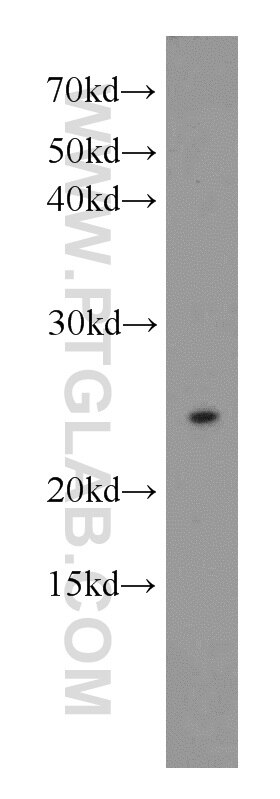N6AMT1 Polyklonaler Antikörper
N6AMT1 Polyklonal Antikörper für WB,ELISA
Wirt / Isotyp
Kaninchen / IgG
Getestete Reaktivität
human, Maus, Ratte
Anwendung
WB, IF,ELISA
Konjugation
Unkonjugiert
Kat-Nr. : 16211-1-AP
Synonyme
Galerie der Validierungsdaten
Geprüfte Anwendungen
| Erfolgreiche Detektion in WB | HEK-293-Zellen |
Empfohlene Verdünnung
| Anwendung | Verdünnung |
|---|---|
| Western Blot (WB) | WB : 1:500-1:1000 |
| It is recommended that this reagent should be titrated in each testing system to obtain optimal results. | |
| Sample-dependent, check data in validation data gallery | |
Veröffentlichte Anwendungen
| WB | See 2 publications below |
| IF | See 1 publications below |
Produktinformation
16211-1-AP bindet in WB, IF,ELISA N6AMT1 und zeigt Reaktivität mit human, Maus, Ratten
| Getestete Reaktivität | human, Maus, Ratte |
| In Publikationen genannte Reaktivität | human, Maus |
| Wirt / Isotyp | Kaninchen / IgG |
| Klonalität | Polyklonal |
| Typ | Antikörper |
| Immunogen | N6AMT1 fusion protein Ag9204 |
| Vollständiger Name | N-6 adenine-specific DNA methyltransferase 1 (putative) |
| Berechnetes Molekulargewicht | 186 aa, 20 kDa |
| Beobachtetes Molekulargewicht | 23 kDa |
| GenBank-Zugangsnummer | BC011554 |
| Gene symbol | N6AMT1 |
| Gene ID (NCBI) | 29104 |
| Konjugation | Unkonjugiert |
| Form | Liquid |
| Reinigungsmethode | Antigen-Affinitätsreinigung |
| Lagerungspuffer | PBS mit 0.02% Natriumazid und 50% Glycerin pH 7.3. |
| Lagerungsbedingungen | Bei -20°C lagern. Nach dem Versand ein Jahr lang stabil Aliquotieren ist bei -20oC Lagerung nicht notwendig. 20ul Größen enthalten 0,1% BSA. |
Protokolle
| Produktspezifische Protokolle | |
|---|---|
| WB protocol for N6AMT1 antibody 16211-1-AP | Protokoll herunterladen |
| Standard-Protokolle | |
|---|---|
| Klicken Sie hier, um unsere Standardprotokolle anzuzeigen |
Publikationen
| Species | Application | Title |
|---|---|---|
Microbiol Immunol BUD23-TRMT112 interacts with the L protein of Borna disease virus and mediates the chromosomal tethering of viral ribonucleoproteins. | ||
Cell Death Dis Association of N6-methyladenine DNA with plaque progression in atherosclerosis via myocardial infarction-associated transcripts. |


